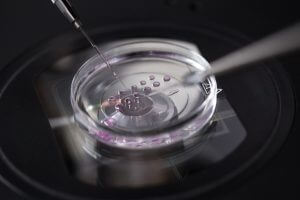Step-by-Step Through In Vitro Fertilization (IVF)
When natural conception isn’t working, we turn to our trusted physicians to explore alternative routes to starting a family. One of the most widely-known treatments in reproductive medicine today is in-vitro fertilization (IVF). It’s one of the most advanced and effective fertility treatments on the market. And with thousands of ORM Fertility babies born through IVF since 1989, we know this treatment has proven results.
What is IVF?
Simply put, IVF is the process of fertilizing a woman’s egg by sperm in a laboratory instead of inside a woman’s body. A seemingly straightforward process, but when you’re seeking fertility treatment to start a family of your own, the options for treatment can seem intimidating and overwhelming. As you begin to consider going through IVF, it can be difficult to understand what it all means. To better understand what the process of IVF looks like, let’s break it down step-by-step:
STEP 1 | Pre-Cycle Testing
Once you’ve made the decision to go through IVF, you’ll meet with one of our physicians one-on-one to help us gain a better understanding of your fertility background. We’ll work with you to develop a personalized fertility care plan that meets your needs.
In order to determine which treatment plan will work best for your family, you’ll undergo some pre-cycle testing. These tests take about two weeks to complete and are performed to gather baseline information about your hormone levels. They also look for any abnormalities in your reproductive system and work to identify other factors that might affect your journey through IVF.
Pre-cycle tests can include:
- Baseline Testing. A panel of blood tests will identify a variety of things such as infectious diseases, hormone levels and more.
- Ovarian Reserve Testing. An estimate of your egg count can be gathered by way of follicle counts via ultrasound and blood work such as anti-Mullerian hormone (AMH) testing.
- Uterine Cavity Evaluation. During this evaluation, we check the uterus for any abnormalities that might inhibit an embryo from implanting or growing in the uterus.
- Semen Analysis. This analysis will look at the morphology, motility, and quantity of sperm being used for fertilization.
STEP 2 | Ovary Stimulation & Egg Production
Once your pre-cycle testing is complete, we’re able to create your unique care plan. The next step? Ovary stimulation and egg growth. If you’re using your own eggs, you’ll begin taking medication to stimulate the follicles (a fluid-filled sac that contains an immature egg) in your ovaries in an effort to produce multiple eggs. You’ll work with your doctor to determine a start date and our nurses will walk you through, step-by-step, how to properly administer the medication at home.
These medications, usually in the form of injections, are made up of follicle-stimulating hormone (FSH) and luteinizing hormone (LH). Both of these hormones are already present in your body, the boost in hormone levels help encourage your ovaries to grow an abundance of eggs.
During this process, you may feel bloated and uncomfortable with a large number of growing eggs in your ovaries. Naturally, a woman’s body releases one egg a month for fertilization but to increase your chances of successful IVF, we want to retrieve as many eggs as possible.
Once the medication has been started, you will be seen every other day to monitor the growth of the follicles and ensure adequate hormone levels. This also provides the physician with an opportunity to adjust medication dosing and answer any questions you may have. After ten to twelve days, most women are ready for their “trigger injection.” This injection prepares the eggs for ovulation, a natural process where a woman’s body releases an egg to be fertilized.
STEP 3 | Egg Retrieval
 The egg retrieval takes place about 36 hours after your trigger injection, right before your body would naturally start to ovulate.
The egg retrieval takes place about 36 hours after your trigger injection, right before your body would naturally start to ovulate.
The egg retrieval is a same-day procedure where eggs are collected from the ovaries and generally takes about 30 minutes. For this procedure, you’ll be under mild sedation, so you won’t feel or remember any of it. A transvaginal ultrasound probe is used to guide a needle into the ovaries to identify follicles. The needle then uses suction to remove the eggs and fluid from each follicle and collects them into tubes to be examined.
The tube is immediately handed to the embryologist, who examines the follicular fluid under a microscope to determine how many mature eggs have been collected. Mature eggs are then placed in culture media to be incubated until they are ready to be fertilized.
This is an exciting time for intended parents. On the day of retrieval, the embryologist and your doctor will tell you the number of eggs retrieved. The following day, the embryologist will let you know the number of eggs that were successfully fertilized.
After the egg retrieval, your ovaries will be enlarged and you may feel cramping, pressure or feelings of fullness for a week or so. These sensations will slowly fade and the ovaries will return to normal after your next period.
STEP 4 | Fertilization
Once the egg retrieval is complete, fertilization can be attempted in two ways:
Conventional Insemination. For this method, an egg is placed in a petri dish with sperm and left to fertilize naturally. This method requires less lab work and is often used for those with an exceptional semen analysis or previously proven paternity.
Those who want to use INVOCELL to achieve conception will allow the eggs and sperm to be placed in a single device to fertilize naturally. The device is then inserted into the vagina immediately after the egg retrieval. The sperm and eggs will meet and grow in the device for 5 days. The device is then removed, the embryologist checks for embryo development and a single embryo is chosen to transfer into the uterus. The remaining embryos are cryopreserved or cultured in the lab for an additional day.
Intracytoplasmic Sperm Injection (ICSI). ICSI is a process by which one sperm is injected directly into a mature egg under a microscope using a very sharp and hollow needle. This process helps the sperm overcome many natural obstacles they might encounter when fertilizing an egg and is widely replacing conventional methods.
Some intended parents may choose to use a mix of both conventional insemination and ICSI for a variety of personal reasons. Your doctor will review these options with you in your initial discussion about IVF to determine which fertilization method is right for you.
STEP 5 | Embryo Growth & Grading
After the eggs have been fertilized, it’s time to let nature take its course for a few days and give the embryos time to grow and develop. They’ll be kept in incubators in ORM’s state-of-the-art lab to help provide the most conducive environment for healthy embryo growth.
Five days after retrieval, the embryos created in the lab are graded by the embryology team to determine which embryos have reached the appropriate stage of development. Embryo grading is used along-side other factors to determine which embryos will be transferred, biopsied, or cryopreserved. Prior to the egg retrieval, your doctor will help you decide which treatment option is best for you.
Should you and your doctor decide upon PGT (Preimplantation Genetic Testing) for the embryos, the embryologist will remove 5 to 10 pre-placental cells to send for genetic analysis. Transferring an embryo that is PGT normal increases the chance of implantation and live birth.
STEP 6 | Embryo Transfer
Before the transfer, our team will ensure the uterine lining is the appropriate thickness and hormone levels are ideal to provide the best environment possible for the embryo to implant. The embryo is loaded into an embryo transfer catheter and carefully passed through the cervix into the uterus. A transabdominal ultrasound is used to ensure the catheter deposits the embryo in the desired location. This procedure is quick with minimal discomfort.
Fresh Embryo Transfer. Five days after the egg retrieval, the embryologist will choose the best embryo(s) to transfer into the uterus.
Natural Embryo Transfer. For this method, we’ll utilize your body’s natural cycle of ovulation. You will be seen mid-cycle for an ultrasound and blood work to confirm ovulation. We’ll coordinate the transfer with your body’s natural implantation window.
Medicated Embryo Transfer. For a medicated embryo transfer, you’ll start on injectable medication to thicken the uterine lining and mimic hormonal changes. You’ll work with your doctor to schedule your transfer day based on your response to the medication.
STEP 7 | Pregnancy Test
 About 9 days after the embryo transfer, a blood test will confirm pregnancy. If the test comes back positive, we will monitor the rise in the pregnancy hormone level over the next several days. Your doctor will monitor the early stages of your pregnancy with ultrasounds at 6 and 10 weeks of pregnancy to confirm heartbeat and development. You will transfer care to your OB provider after 10 weeks of gestation.
About 9 days after the embryo transfer, a blood test will confirm pregnancy. If the test comes back positive, we will monitor the rise in the pregnancy hormone level over the next several days. Your doctor will monitor the early stages of your pregnancy with ultrasounds at 6 and 10 weeks of pregnancy to confirm heartbeat and development. You will transfer care to your OB provider after 10 weeks of gestation.
If you are not pregnant after your first embryo transfer, don’t be discouraged. Sometimes, it takes more than one transfer to achieve a successful pregnancy. We’ll be with you every step of the way to help you realize your dream of growing your family.
Ready to take the first step? Connect with our team to schedule a personalized one-on-one with one of our caring physicians and learn how ORM Fertility can help you grow your family!
[button animation=”none” variant=”1″ icon=”icomoon-home” background=”#739D8B” color=”#FAF7EF” size=”small” url=”https://ormfertility.com/connect/” target=”_blank” ]Connect With Us[/button]




